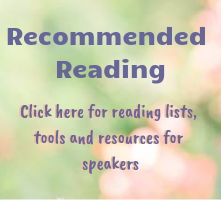Public speaking gestures: Too many "don'ts"
I read another article the other day that misrepresented Albert Mehrabian's research. This time, the author was using the statistic to demonstrate how important gestures are to our presentations.
The author delivered a list of cleverly-named things we do with our hands and arms when we're not gesturing appropriately (one I've read elsewhere: T-Rex, when our hands hang in front of our waist like the dinosaur's stance).
The suggestions included: Don't stroke your beard, don't push your hair back, don't touch what you're wearing, don't put your hands in your pockets, don't hold them at your waist, don't put them behind you or in front of you, don't lean on the lectern, don't restrict your movements, don't have too many movements, and more.
I can see why newcomers to speaking often feel so terrified: The "rules" of speaking often seem overwhelming, and never so much so as when one rule appears to contradict another: don't restrict your gestures, but don't gesture too much? How does one navigate these complicated instructions?
I'm going to give you a simple suggestion. None of these gestures is wrong. As with most things about public speaking, we get into trouble when we enter the realm of distraction. If you put your hands in your pockets for a moment, or adjust your sweater once or twice, you are not going to drive the audience crazy and they will not perceive you as nervous or skittish.
It's only if you do a lot of these things, or if you do one of them over and over, that gestures become distracting. If you inhibit your gestures or use repetitive and unconscious movements, the audience will indeed notice.
Variety in your gestures is okay. Small movements, big movements, even leaning on the lectern with one elbow for a few seconds while you make a point. It's okay.
Don't let the minutiae of public speaking "rules" intimidate you or keep you from getting on stage.
Allow your gestures to develop naturally, the way you do when talking to friends or colleagues. Be aware of them, yes. Be conscious of your movements, and even videotape your practice sessions so you can get a handle on any repetitive or distracting motions.
But there are much more important things to worry about when speaking than "Oh no, I just touched my tie!" Like valuable content and authentically connecting with the audience.
____________________________________________________
On The Everything Page you'll find everything you need to build visibility, credibility and influence through engaging presentations that move your participants into action: freebies, low-cost products and courses, and 1:1 coaching!




0 comments. Please add yours! :
Post a Comment